“We need a bench” was the extent of the direction given for this project. I doubt that anyone would have objected if I had made it with a spruce 2 x 12 and common nails, but I thought a retail space called for something a little nicer, so I went out to the lumber trees and picked up some 5/4 Red Balau deck boards to see how they would work. The so-called “Phillipine Mahogany” is very dense and hard (and heavy) so I figured it would be durable enough for banging around with the garden tools. I had already used it for the frame of my outfeed and assembly table set up behind the shop table saw so I knew of its stability.
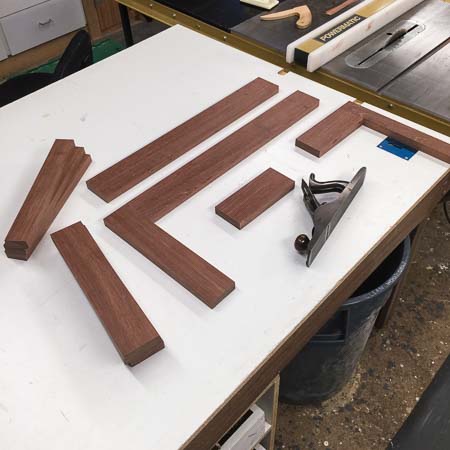 After some lower school arithmetic, I cut the various pieces to their proper sizes and cut slots for biscuits to join the rails and leg parts. I remember the first few times I used biscuits for joinery, borrowing a Lomello tool and using their proprietary biscuits for some cabinet face frames. The tolerances were so close that the biscuits had to be sealed against ambient moisture until use or they would swell and not fit in the slots. While they required extra care, they located the joining pieces very precisely, so it was worth the effort. The biscuits I get today are a different story. They are without exception loose in the slots so a precise alignment is no longer a given, or even a likelihood. It took me a lot of grousing and grumbling until I realized that I could do to them what I worked to prevent with the Lomello biscuits; make them swell! Now when biscuiting I soak the little plywood bits in a cup of water for a minute or so and get the snug fits that put the corresponding pieces just the way I intend.
After some lower school arithmetic, I cut the various pieces to their proper sizes and cut slots for biscuits to join the rails and leg parts. I remember the first few times I used biscuits for joinery, borrowing a Lomello tool and using their proprietary biscuits for some cabinet face frames. The tolerances were so close that the biscuits had to be sealed against ambient moisture until use or they would swell and not fit in the slots. While they required extra care, they located the joining pieces very precisely, so it was worth the effort. The biscuits I get today are a different story. They are without exception loose in the slots so a precise alignment is no longer a given, or even a likelihood. It took me a lot of grousing and grumbling until I realized that I could do to them what I worked to prevent with the Lomello biscuits; make them swell! Now when biscuiting I soak the little plywood bits in a cup of water for a minute or so and get the snug fits that put the corresponding pieces just the way I intend.
I wanted the bench to have tapered legs so it would have a lighter look than it would with straight legs. This required a taper jig for the table saw so I made a quick, non-adjustable one out of a balau scrap.
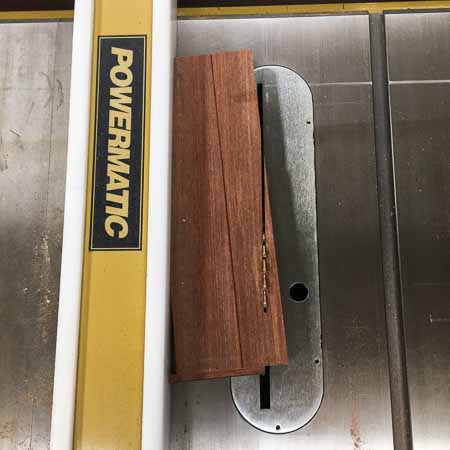 The legs are built of two parts that combine when the sides and ends of the bench are biscuited and glued together at right angles, giving the legs a substantial look from the outside without needing to be of solid stock.
The legs are built of two parts that combine when the sides and ends of the bench are biscuited and glued together at right angles, giving the legs a substantial look from the outside without needing to be of solid stock.
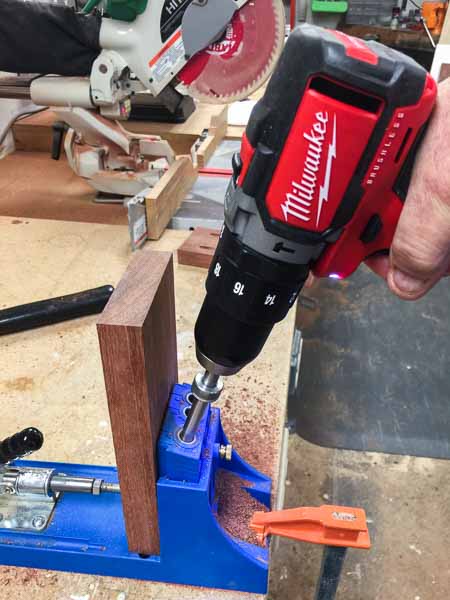 The side and end rails are also pocket-screwed together. The dense Red Balau provided a good opportunity to give the new Milwaukee M18™ ½” Compact Brushless Hammer Driver/Drill a run to see how it compared to its big brother. The literature that came with my Kreg Jig advised the use of a corded drill, for reasons unknown, but the compact is just as capable as the larger, more powerful M18™ Fuel™ drill and both are perfectly capable of doing all of pocket cutting I do. A more thorough look at these tools is coming.
The side and end rails are also pocket-screwed together. The dense Red Balau provided a good opportunity to give the new Milwaukee M18™ ½” Compact Brushless Hammer Driver/Drill a run to see how it compared to its big brother. The literature that came with my Kreg Jig advised the use of a corded drill, for reasons unknown, but the compact is just as capable as the larger, more powerful M18™ Fuel™ drill and both are perfectly capable of doing all of pocket cutting I do. A more thorough look at these tools is coming.
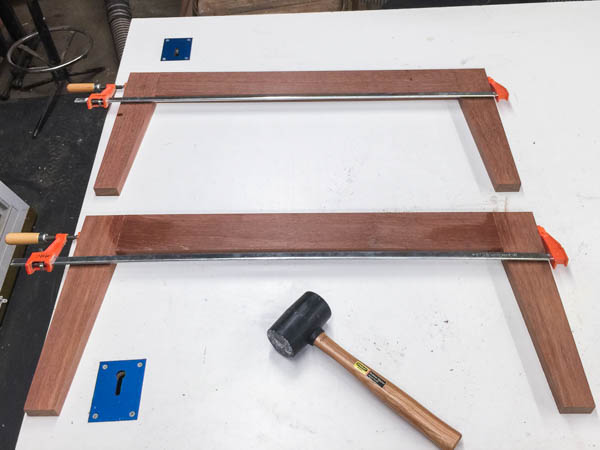 The assembly began with the half-legs joined to the rails. When each of the four sides are glued up, they’re ready to be biscuited together.
The assembly began with the half-legs joined to the rails. When each of the four sides are glued up, they’re ready to be biscuited together.
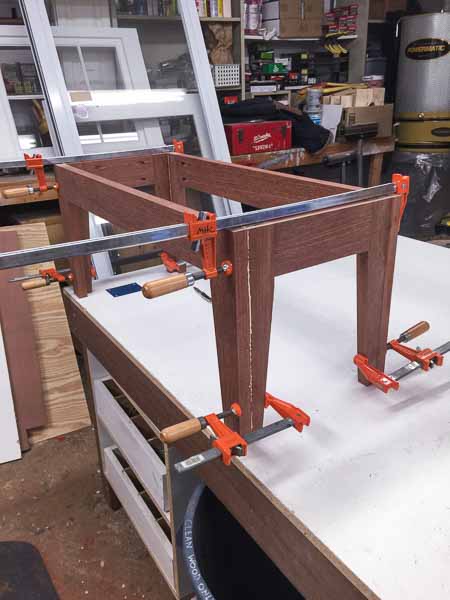 The base with all four sides glued and clamped.
The base with all four sides glued and clamped.
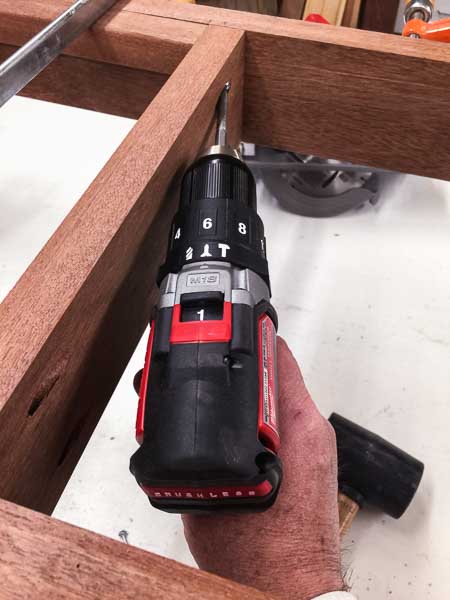 The compact size of this new family of cordless tools is appreciated when having to drive fasteners in tight spaces. This drill/driver is more than an inch shorter than my previous “compact” of another make. The considerably lighter weight of these tools is a boon to anyone engaged in overhead work or repetitive motion such as found in a lot of production jobs. Here I’m fastening a spreader to the middle of the bench to support the seat boards in the middle of the span.
The compact size of this new family of cordless tools is appreciated when having to drive fasteners in tight spaces. This drill/driver is more than an inch shorter than my previous “compact” of another make. The considerably lighter weight of these tools is a boon to anyone engaged in overhead work or repetitive motion such as found in a lot of production jobs. Here I’m fastening a spreader to the middle of the bench to support the seat boards in the middle of the span.
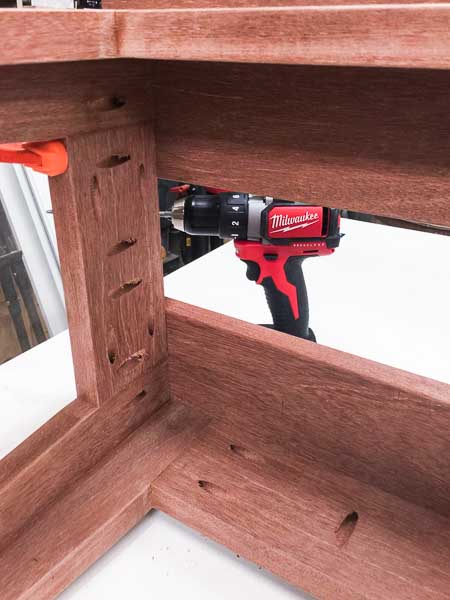 More pockets here than in a pair of cargo pants! The pocket screws fasten the legs to the rails and will hold the seat boards to the base. A couple of the holes intersected, causing an objection from the drill bit, as the earlier holes already had screws in them.
More pockets here than in a pair of cargo pants! The pocket screws fasten the legs to the rails and will hold the seat boards to the base. A couple of the holes intersected, causing an objection from the drill bit, as the earlier holes already had screws in them.
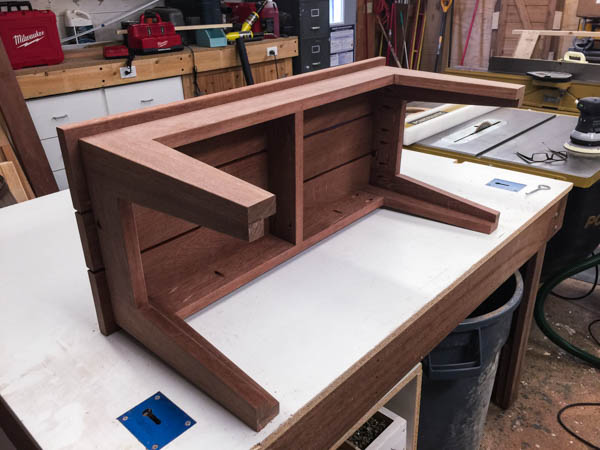 Everything is glued up and screwed down. All the fasteners are applied through the bottom so none show on the top. It gives a cleaner look and saves a lot of work finishing the outside.
Everything is glued up and screwed down. All the fasteners are applied through the bottom so none show on the top. It gives a cleaner look and saves a lot of work finishing the outside.
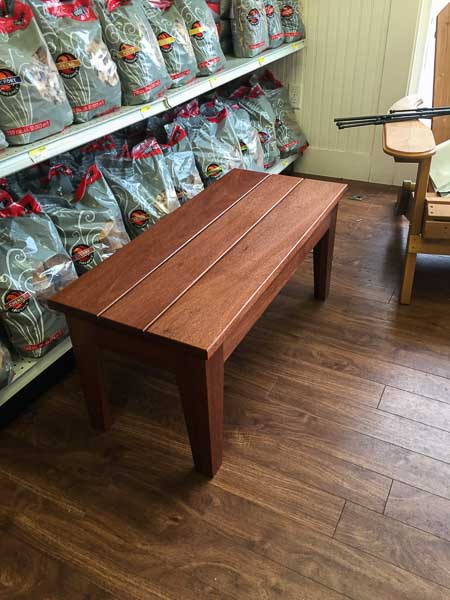 After several coats of Minwax Helmsman Spar Urethane, the bench is delivered to the department where it will be used by costumers trying on a new line of gardening boots.
After several coats of Minwax Helmsman Spar Urethane, the bench is delivered to the department where it will be used by costumers trying on a new line of gardening boots.
The Kayu Batu brand of Red Balau hardwood, Kreg tools and Minwax products are available at Marine Home Center. The line of Milwaukee cordless tools can be special ordered through Marine as well.

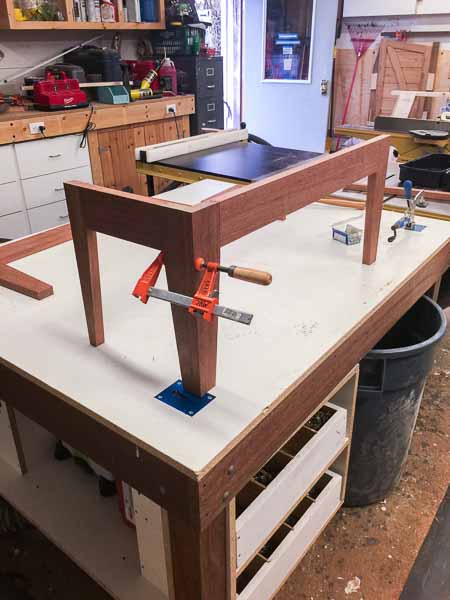

Thank you Josh. I guess you could call it a design. I think of it as a number of details I have seen out and about.
Fine work, Dirck! Is this bench of your own design?